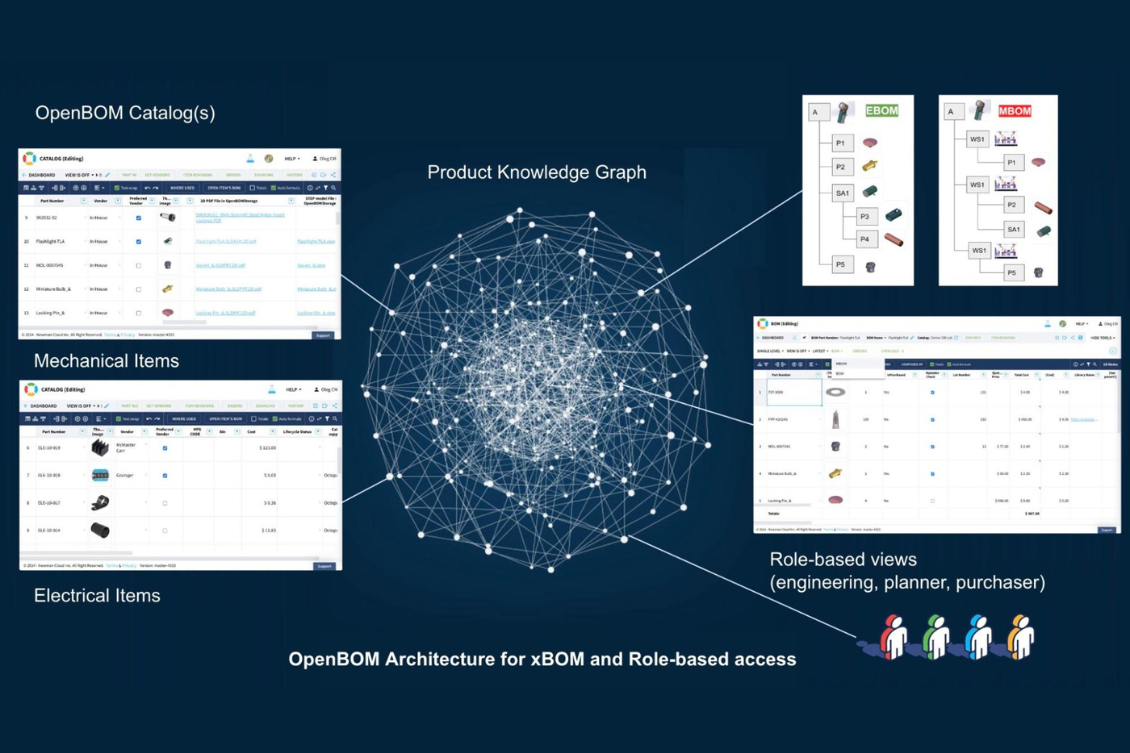
Last week, we introduced a new and groundbreaking service – xBOM, designed to support complex product development and lifecycle management. This innovative service expands the horizons and capabilities of OpenBOM, offering unprecedented flexibility and control over BOM management. If you missed that news and publications, please check out our earlier articles:
- OpenBOM Introduces xBOM Simplifying Complex BOM and Digital Thread Management
- Introducing xBOM Service: BOM Management Use Cases
In my article today, I want to explore deeper into OpenBOM’s data management architecture for xBOM, shedding light on the robust framework that supports this advanced service. Be sure to check our previous articles and press releases for more context and insights.
Five Elements of OpenBOM xBOM Architecture
The OpenBOM xBOM architecture is built on five key elements, each playing a crucial role in supporting flexible data management and access control:
- Object Model for Flexible Data Management The foundation of our architecture is the object model, which facilitates the definition and management of item catalogs. This model allows users to create a structured and adaptable framework for their data, ensuring that all product information is accurately captured and easily accessible. Check more information about the OpenBOM data model and how OpenBOM delivers the flexibility of the data model for our customers.
- Product Knowledge Graph Our Product Knowledge Graph is a sophisticated tool used to define multiple relationships between data elements, such as BOMs and other related information. This graph-based approach enables a comprehensive view of product data, highlighting connections and dependencies that are essential for effective lifecycle management.
- BOM Data Modeling for Instance-Reference Relationships BOM data modeling is essential for managing the relationships between different instances and references within a product’s lifecycle. Essentially, these relationships allow you to build a product structure. This element ensures that all variations and configurations of a product are accurately represented, facilitating precise tracking and management.
- Specific BOM Types – EBOM and MBOM OpenBOM supports specific BOM types, such as Engineering BOM (EBOM) and Manufacturing BOM (MBOM), while maintaining complete flexibility for customization. Users can tailor these BOM types to meet their specific needs, ensuring that the architecture adapts to various use cases and requirements. This is a key element of the OpenBOM xBOM model.
- Role-Based Views for Access Control Role-based views are crucial for providing seamless data access to specific groups of users, such as engineers, procurement specialists, and production engineers. These views ensure that each user group has access to the information they need, enhancing collaboration and efficiency across the organization.
Let’s speak about each of these elements of OpenBOM architecture.
Object Model for Flexible Data Management
The object model in OpenBOM is designed to handle diverse data types and structures. It allows users to define item catalogs with various attributes and relationships, supporting a dynamic and scalable data management approach.
Product Knowledge Graph
The Product Knowledge Graph leverages graph database principles to map out complex relationships between different data elements. This method provides a clear and interconnected view of all product-related information, facilitating better decision-making and lifecycle management.
BOM Data Modeling for Instance-Reference Relationships
By modeling instance-reference relationships, OpenBOM ensures that each variation of a product is accurately documented. This approach supports configuration management and helps track changes and updates throughout the product life cycle.
Specific BOM Types – EBOM and MBOM
OpenBOM’s flexibility in defining different BOM types (eg. EBOM and MBOM) allows users to customize these BOMs to fit their specific workflows. This customization capability ensures that the BOMs align with the unique processes and requirements of each organization.
Role-Based Views for Access Control Role-based views in OpenBOM provide targeted access to data, ensuring that users see only the information relevant to their roles. This approach enhances security, improves workflow efficiency, and supports effective collaboration across different departments.
Three Unique Differentiators of OpenBOM Architecture
- Multi-Tenant Framework OpenBOM’s architecture is built on a multi-tenant framework, enabling multiple users and organizations to share the same infrastructure while maintaining data isolation and security. This design supports scalability and cost-effectiveness, making it an ideal solution for companies of all sizes.
- Graph-Based Data Management The use of a graph-based approach for data management allows OpenBOM to handle complex relationships and dependencies with ease. This method provides a more intuitive and interconnected view of product data, facilitating better analysis and decision-making.
- Real-Time Collaboration and Instant Data Sharing OpenBOM’s architecture supports real-time collaboration and instant data sharing, enabling teams to work together seamlessly, regardless of their physical location. This capability enhances productivity and ensures that all stakeholders have access to the most up-to-date information.
Conclusion
OpenBOM’s architecture provides a unique mechanism for managing data with a high level of structuring for different BOM types and role-based access. The xBOM service, with its flexible and robust framework, sets a new standard for BOM management in complex product development and lifecycle scenarios. We invite you to check out OpenBOM xBOM and learn more about how it can transform your data management processes.
Interested to learn more about how OpenBOM xBOM can help you?
REGISTER FOR FREE and schedule a demo with OpenBOM specialists.
Best, Oleg
Join our newsletter to receive a weekly portion of news, articles, and tips about OpenBOM and our community.










